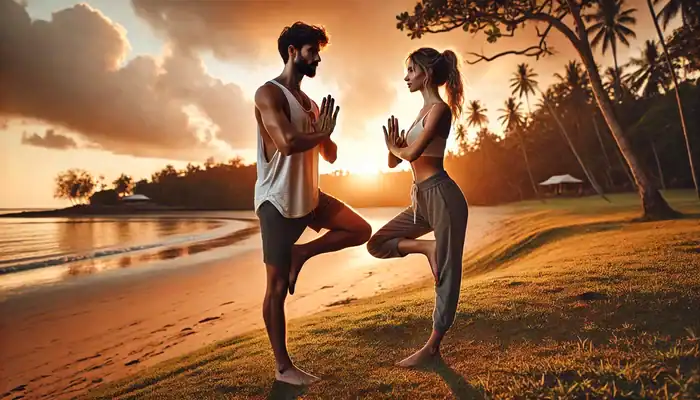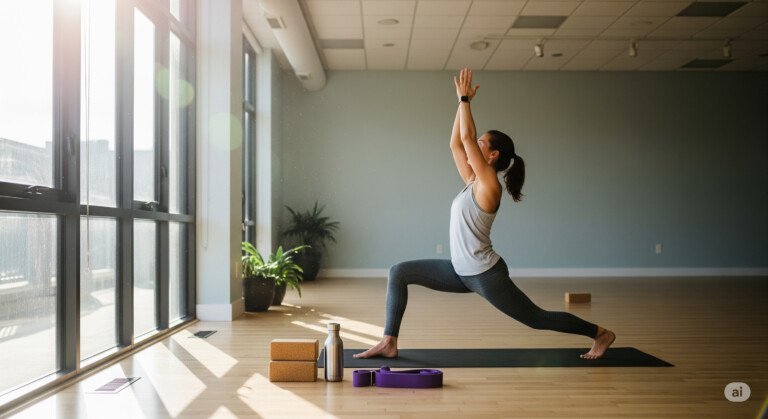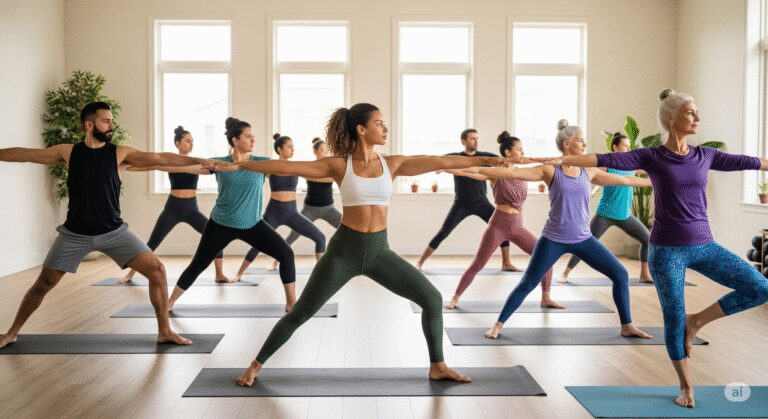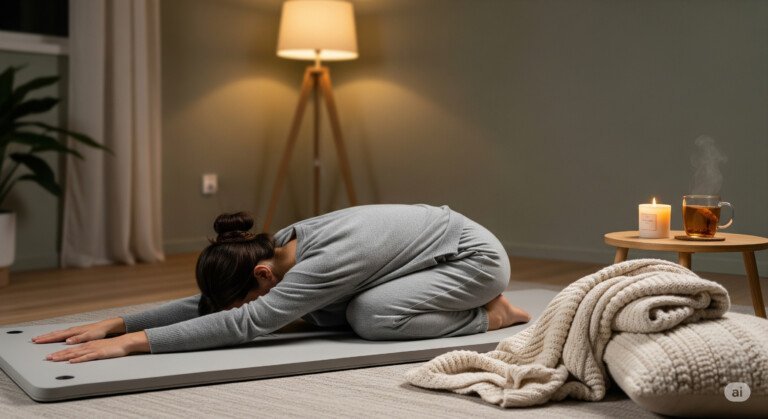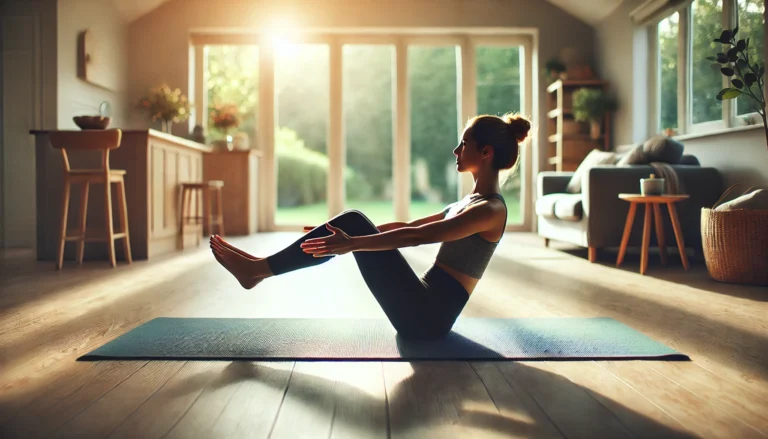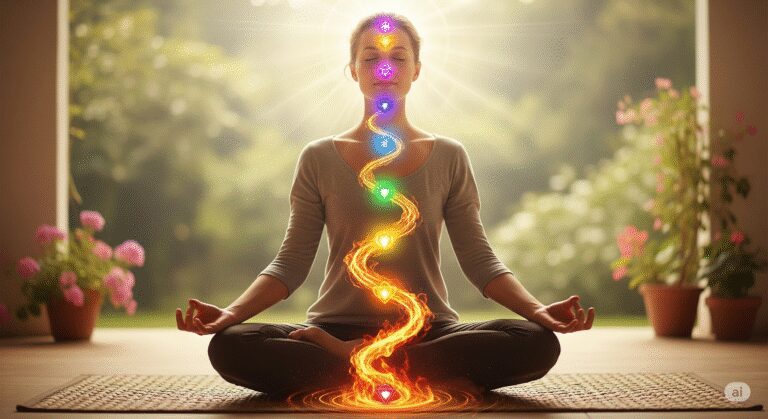7 Fun Yoga Poses for 2 People That Build Trust & Connection
Yoga poses for 2 people are more than just playful stretches — they’re an opportunity to deepen trust, communication, and emotional connection. Whether you’re practicing with a partner, friend, or even a child, these partner yoga poses help you sync your breath, share your balance, and strengthen your bond — both physically and spiritually. In this post, we’ll explore 7 fun, beginner-friendly yoga poses designed to create laughter, release tension, and bring two hearts closer, one breath at a time. Whether you’re looking for couples yoga to reignite intimacy or simply want to try acro yoga for fun, this guide will inspire connection on the mat and beyond.
Thank you for reading this post, don't forget to subscribe!The Magic of Yoga for Two
Yoga is often practiced solo — a deeply personal ritual of breath, awareness, and movement. But there’s a lesser-known side to this ancient practice that can be just as powerful: yoga poses for 2 people.
Whether it’s with your partner, a close friend, or even your child, partner yoga opens up an entirely new layer of emotional and physical connection. It transforms yoga from a personal journey into a shared exploration of trust, communication, and presence.
Here’s why it matters:
- Trust and Vulnerability: Partner poses often require one person to support the other, both physically and emotionally.
- Deep Listening: You must listen not only to your own body, but also to your partner’s breath, energy, and comfort level.
- Playfulness and Fun: Laughter is guaranteed. Some poses may be awkward at first — but that shared discomfort often turns into connection.
- Emotional Intimacy: Moving in sync fosters a subtle yet powerful emotional bonding, especially for couples or close friends.
Imagine starting your morning with a shared breathing ritual that grounds you both. Or ending the day with a supported backbend that melts away tension while your partner holds space for your release.
In this blog, we’ll walk you through 7 carefully chosen yoga poses for 2 people that are suitable for beginners and deeply rewarding for the soul. These aren’t acrobatic circus acts — they’re accessible, beautiful, and designed to build real-life trust and emotional alignment.
Whether you’re a couple looking to rekindle connection, or two friends seeking a unique bonding activity, this guide is your blueprint.
What You’ll Discover:
- Beginner-friendly partner poses (no experience needed)
- Emotional and physical benefits of yoga for two
- Safety tips and communication guidelines
- Beautiful rituals for building trust and intimacy
- Bonus: 5 FAQs about couples yoga and acro yoga
Let’s begin this journey of connection — one mindful pose at a time.
[Insert Affiliate Banner #1: High-quality yoga mats, couples meditation kits, or yoga-for-beginners online class]
Understanding Partner Yoga, Acro Yoga & Couples Yoga
Before jumping into the poses, it’s important to understand the different forms of yoga with two people. Many beginners wonder: What’s the difference between partner yoga, acro yoga, and couples yoga? Let’s break it down so you know exactly what you’re practicing.
What Is Partner Yoga?
Partner yoga is a style where two individuals work together to deepen stretches, improve balance, and support each other physically and emotionally.
It’s not about being perfectly flexible or acrobatic — the focus is on:
- Communication
- Cooperation
- Mindful touch
- Mutual support
Some poses involve synchronized breathing while sitting back-to-back. Others involve one person assisting another into a deeper stretch.
🔹 Think of partner yoga as a gentle invitation to explore how two bodies can create harmony through movement.
What Is Acro Yoga?
Acro yoga combines:
- Yoga
- Acrobatics
- Thai massage elements
It typically involves two roles:
- The base (lying or standing)
- The flyer (lifted off the ground)
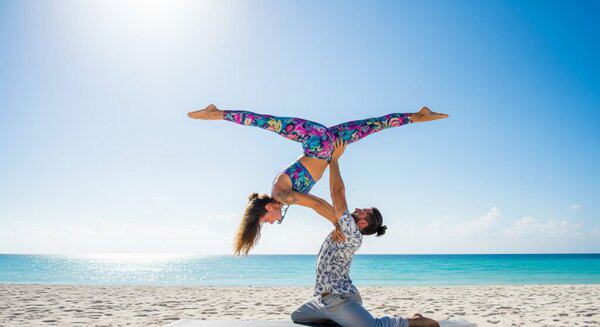
This is more playful and physically demanding. You might see poses where one partner balances the other on their feet or hands in the air.
While some acro poses require strength and skill, many beginner-friendly ones are surprisingly accessible with proper communication and safety. We’ll include one fun acro-inspired pose in this guide!
Benefits of Acro Yoga:
- Builds deep trust and teamwork
- Enhances body awareness and balance
- Requires complete presence and communication
What Is Couples Yoga?
Couples yoga is essentially partner yoga with emotional intimacy at the forefront. While the poses can be similar to any partner yoga sequence, the intention shifts more toward:
- Emotional bonding
- Relationship healing
- Non-verbal communication
- Mindful touch and affection
You don’t need to be in a romantic relationship to enjoy this — but when done with a partner or spouse, it can become a beautiful tool for:
- Rebuilding connection
- Deepening empathy
- Creating sacred time together
Summary: Key Differences
| Type | Focus | Suitable For | Typical Poses |
|---|---|---|---|
| Partner Yoga | Support, flexibility, balance | Friends, family, couples | Back-to-back poses, assisted folds |
| Acro Yoga | Strength, balance, trust | Confident beginners up | Lifts, flying poses, dynamic holds |
| Couples Yoga | Emotional connection, bonding | Romantic partners | Heart openers, eye-gazing, tandem breath |
Who Can Try Yoga for Two?
Absolutely anyone. These practices are:
- Gender-neutral
- Age-inclusive
- Perfect for beginners
All you need is a willing partner, a soft surface, and an open mind.
Tip: If you’re shy or nervous, start with simple back-to-back seated breathing (explained in Pose 1) to ease into the experience.
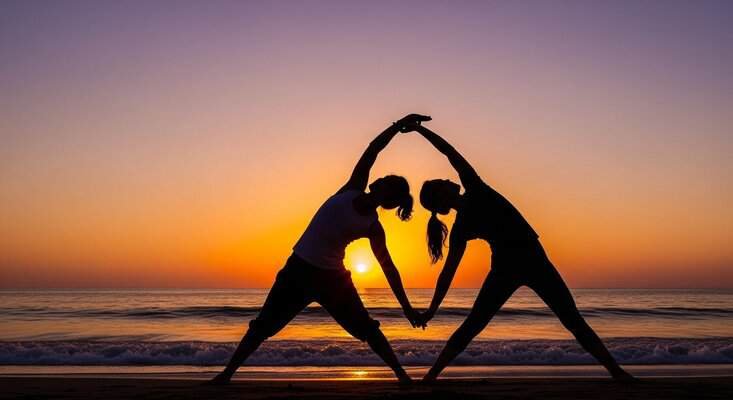
Before You Begin – Safety, Setup & Mindset
Now that you understand what partner yoga and acro yoga are, it’s time to prepare your space and your energy. While yoga poses for 2 people can be playful and lighthearted, they also require mutual respect, mindfulness, and communication.
Here’s how to create the perfect setup for a successful session.
1. Choose the Right Space
Find a calm, open area that allows you both to stretch without bumping into furniture or distractions.
Recommended:
- Soft carpeted floors or yoga mats
- Outdoor settings (parks, beach, terrace)
- Quiet rooms with minimal noise
Turn off notifications — your phone can wait.
Optional Upgrade: Add ambiance with aromatherapy oils, a salt lamp, or calming music.
2. Wear the Right Clothing
Comfort is key — and so is flexibility.
What to wear:
- Breathable yoga pants or leggings
- Fitted tops (to avoid sliding during poses)
- Avoid jewelry, belts, or zippers
Both partners should feel confident and able to move freely.
3. Warm Up Together
Don’t dive directly into deep poses — warm up with individual stretches first, then sync up with light partner movements.
Suggested warm-up sequence:
- Neck rolls
- Shoulder circles
- Cat-cow poses (do side-by-side or facing each other)
- Seated twist
- Wrist circles
Finish the warm-up by sitting back-to-back, taking 5 deep breaths in unison — inhaling peace, exhaling tension.
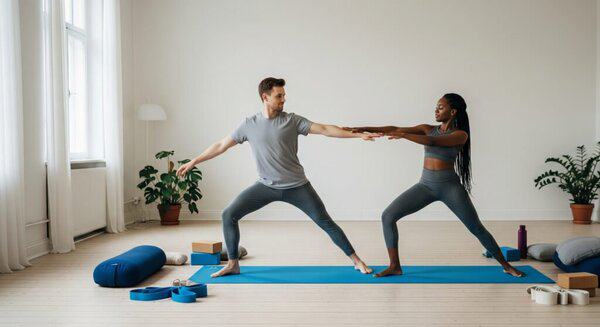
4. Set a Shared Intention
Before you begin the poses, pause and ask each other:
“What do we want to feel or create in this session?”
Some intentions might include:
- Connection
- Playfulness
- Healing
- Mindfulness
- Trust
Speaking your intention aloud creates shared awareness and emotional grounding.
5. Understand the Safety Rules
Even beginner-friendly partner poses involve shared weight and balance — so safety is essential.
Golden Rules:
- Communicate before, during, and after each pose
- Check in often: “How does this feel?” / “Okay if I lean more?”
- Never pull or yank a partner into a stretch
- Stop immediately if there’s discomfort or instability
- Support each other when coming in/out of poses
Never force a stretch. Every body has its own edge — honor that.
6. Establish Physical Cues
Sometimes words aren’t enough — physical cues help partners stay in sync.
- A light squeeze of the hand = “Let’s pause here”
- A gentle tap = “I’m ready to go deeper”
- A soft pull = “Please help guide me back up”
These cues become especially important in balancing or inversion poses.
7. Let Go of Performance
This isn’t a competition. It’s not about doing the pose “perfectly.” It’s about:
- Laughing when you fall
- Feeling into the connection
- Staying present together
The yoga happens not in the pose — but in the moment shared between the pose.
Trust-building tools, partner yoga video course, or eco-friendly yoga props
Pose 1 to Pose 7 – Starting with Grounding & Connection
Now that you’re physically and mentally prepared, it’s time to dive into the actual poses. These first three are gentle, grounding, and perfect for beginners. They’re designed to help you tune into each other’s breath, posture, and energy — while easing into physical support and trust.
1. Seated Back-to-Back Breathing
Best for: Emotional synchronization, calming nerves, beginner partner practice
Type: Grounded / Meditative / Breath Awareness
How to do it:
- Sit cross-legged, back-to-back with your partner.
- Feel each other’s spine. Try to align your posture evenly.
- Close your eyes. Rest your hands on your knees or thighs.
- Begin by simply observing your own breath.
- After a few rounds, try to sync your inhale and exhale with your partner’s.
- Breathe together for 2–5 minutes.
Emotional Benefits:
- Creates a calm, shared rhythm
- Fosters non-verbal trust
- Begins the yoga bonding process in stillness
Tip: Use a calming mantra like “I trust. I support.” silently as you breathe.
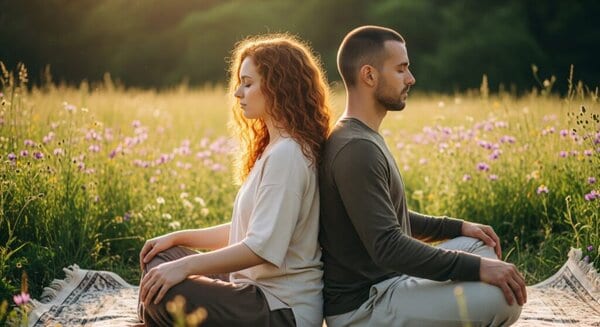
2. Double Tree Pose
Best for: Balance, light challenge, playfulness
Type: Standing / Balancing / Teamwork
How to do it:
- Stand side by side, shoulders touching slightly.
- Each person lifts their inner leg and places the sole of the foot against their standing thigh or calf (not the knee).
- Bring your palms together in front of you — or raise your outer arms overhead.
- Engage your core, look straight ahead, and balance for 5–10 breaths.
Emotional Benefits:
- Develops mutual grounding
- Enhances trust in physical and energetic alignment
- Encourages shared focus and laughter
Challenge version: Try closing your eyes for a few seconds together. Expect giggles!
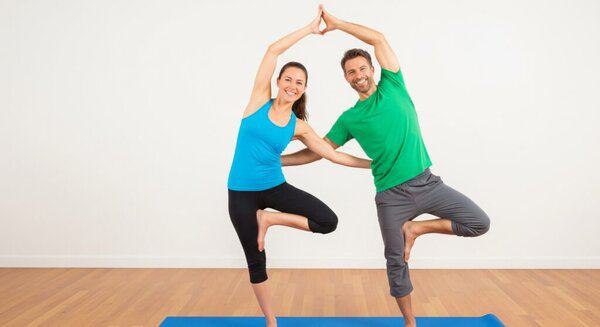
3. Seated Forward Fold Pull
Best for: Hamstring stretch, back release, shared flexibility
Type: Seated / Stretching / Trust & Resistance
How to do it:
- Sit facing each other, legs extended and wide in a V shape.
- Press your feet sole-to-sole (or rest gently against each other’s ankles).
- Hold hands firmly.
- One partner leans back slightly while gently pulling the other partner into a forward fold.
- Stay for 5 breaths, then switch roles.
Emotional Benefits:
- Builds trust through physical resistance
- Teaches active listening through body language
- Deepens flexibility while being supported
Tip: Communicate your limits clearly — say “stop” or “a bit deeper” based on how your body feels.
Strength, Lifts, and Playful Acro Trust Builders
The next two poses introduce light acro yoga elements and muscle engagement. Don’t worry — you don’t need circus skills. These poses are fully beginner-friendly and designed to build trust, balance, and communication while adding a touch of playful challenge.
4. Double Downward Dog (Partner Pyramid)
Best for: Shoulder strength, trust, alignment
Type: Inversion / Stretch / Light Acro
How to do it:
- Partner A starts in traditional downward dog: hands and feet on the mat, hips lifted in an inverted V.
- Partner B stands behind and places their hands a few feet in front of Partner A’s.
- Partner B places their feet gently on Partner A’s lower back or hips (NOT spine).
- Adjust the balance and hold for 3–5 breaths.
Make sure:
- Partner A feels strong and stable.
- Partner B doesn’t dump too much weight.
- Communicate: “Are you okay?” or “Need to come down?”
Emotional Benefits:
- Requires complete verbal coordination
- Builds body awareness and mutual trust
- Fun & rewarding when executed together
Bonus variation: Partner B can gently sway their hips for a shared movement rhythm.
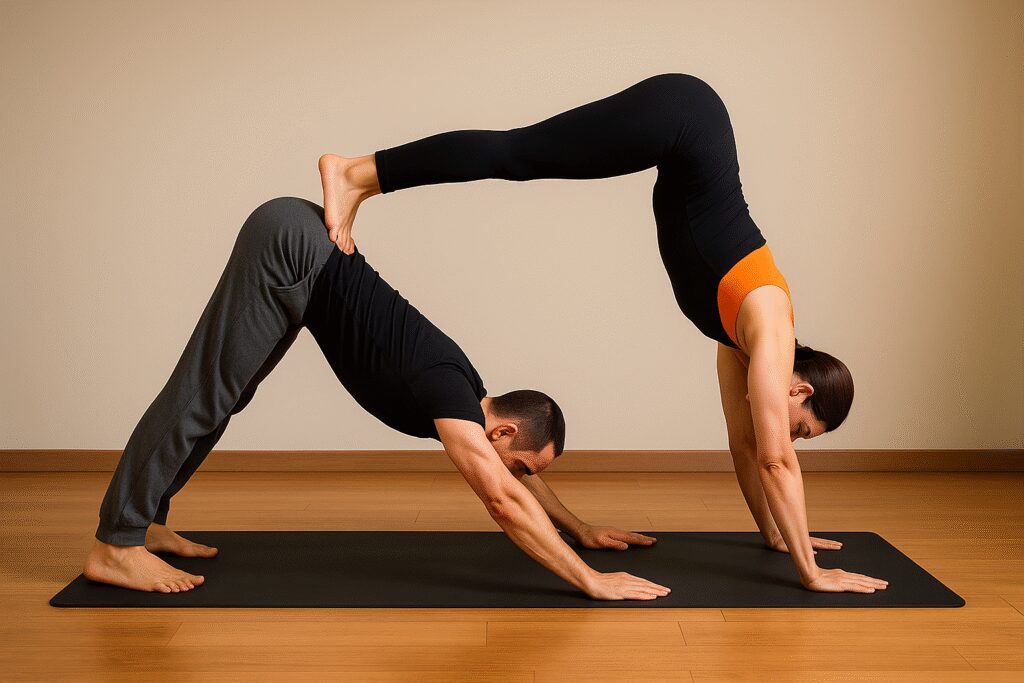
5. Partner Boat Pose (Navasana)
Best for: Core strength, balance, eye contact, fun
Type: Seated / Balance / Core
How to do it:
- Sit facing each other with knees bent and toes touching.
- Hold hands outside your legs.
- Press the soles of your feet together and lift both legs to form a “V” with your bodies.
- Engage your core to maintain balance.
- Hold for 5–10 breaths — and smile at each other!
You can also rock gently back and forth or try singing the alphabet to make it more playful.
Emotional Benefits:
- Activates playfulness and laughter
- Engages deep eye contact and coordination
- Strengthens core connection — physically and emotionally
Challenge variation: Try letting go of one hand and reaching up with the other. Then switch.
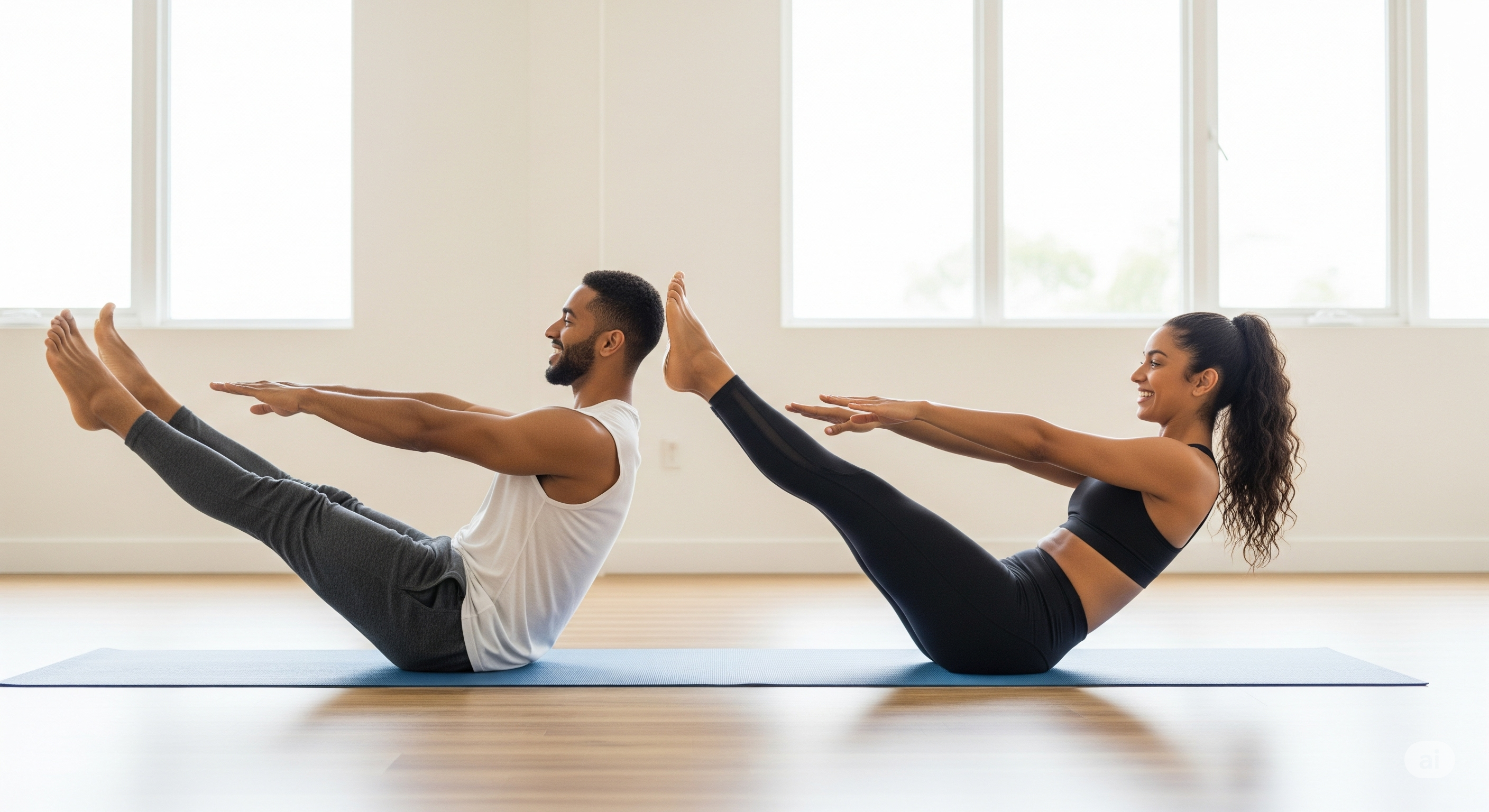
Core yoga tools, partner strength accessories, resistance bands
The Heart-Opening Camel for Vulnerability & Love
As we move into deeper emotional territory, this next pose is perfect for releasing tension, opening your heart space, and encouraging emotional intimacy.
Whether you’re close friends or romantic partners, this is a gentle yet powerful way to feel emotionally supported.
6. Twin Camel Pose (Back-to-Back Heart Opener)
Best for: Heart opening, emotional vulnerability, posture support
Type: Kneeling / Backbend / Emotional Release
How to do it:
- Both partners kneel back-to-back, knees hip-width apart, toes flat or tucked under for support.
- Gently reach behind and interlock arms or hold each other’s wrists or forearms.
- Slowly arch your backs together — leaning into the stretch while supporting each other’s weight.
- Let your heads gently tilt back, eyes closed.
- Breathe deeply into the chest and belly, holding for 4–6 breaths.
What to focus on:
- Don’t force the backbend — use your partner’s support as a guide, not a crutch.
- If one partner is more flexible, they can help stabilize the other with gentler support.
- Let go of tension — especially in your jaw, shoulders, and neck.
Emotional Benefits:
- Deepens trust by opening your most vulnerable physical area — the heart.
- Encourages emotional letting go while being held and supported.
- Releases blocked emotions (tears are welcome and normal).
- Fosters a sense of non-verbal intimacy and presence.
Optional Ritual:
After coming out of the pose, remain kneeling and place your hands on your heart. Take a breath and say aloud:
“Thank you for supporting me. I see you. I feel you. I’m here.”
This moment of spoken presence can be incredibly healing — especially for couples or those healing emotional wounds.
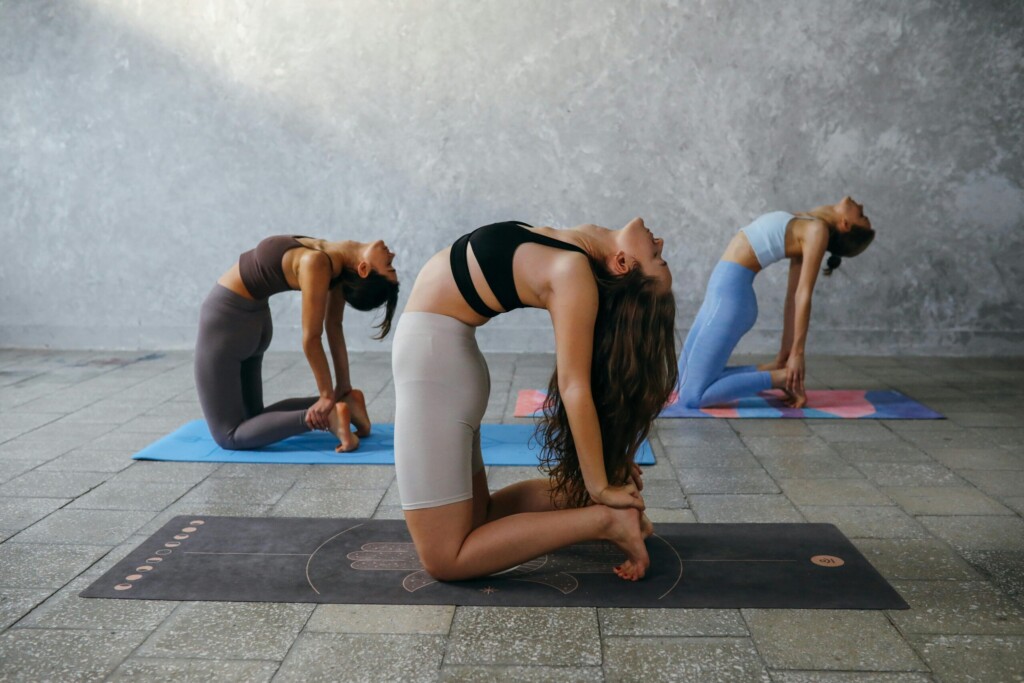
Safety Tip:
If either of you has lower back pain, go slow and keep the arch minimal. Use folded blankets under your knees for comfort.
Energy Focus: Heart Chakra
This pose is deeply connected to Anahata (heart chakra) — the center of compassion, love, and forgiveness. Practicing it with someone you trust can help dissolve walls and improve emotional clarity.
Optional Add-On Tools:
- Rose quartz crystal between your palms
- Heart chakra essential oils (e.g., rose, geranium, or jasmine)
- Soft healing music (e.g., Tibetan bowls or heart mantras)
7. The Trust Fall Stretch (Assisted Standing Forward Fold)
This final pose is a symbolic and physical expression of surrender and support. Often called the “trust fall yoga pose,” it combines a deep forward fold with full reliance on your partner’s strength and care.
It’s a beautiful way to end your partner yoga session, anchoring you both in mutual respect, safety, and emotional release.
Assisted Standing Forward Fold (Trust Fall Stretch)
Best for: Releasing tension, building surrender, restoring trust
Type: Standing / Assisted / Therapeutic
How to do it:
- Partner A stands upright in Tadasana (Mountain Pose).
- Partner B stands in front, back facing Partner A.
- Partner B gently folds forward, relaxing their upper body down like a rag doll.
- Partner A reaches under B’s arms and holds their wrists, forearms, or upper arms securely.
- Once stable, Partner A lifts gently upward to allow Partner B’s upper body to hang freely.
- Stay here for 5–10 breaths, then gently guide B back up, and switch roles.
Key Tips for Safety:
- The base (Partner A) should engage their core and avoid leaning backward.
- Make sure Partner B relaxes fully but communicates if there’s discomfort or lightheadedness.
- The lift should be gentle, not yanking — the goal is support, not traction.
Emotional Benefits:
- Encourages emotional surrender in a supported environment.
- Builds non-verbal emotional trust — especially for those healing from betrayal or anxiety.
- Physically decompresses the spine, neck, and shoulders.
- Serves as a symbolic letting go of past heaviness — with someone literally “having your back.”
Ritual Add-On:
As Partner B relaxes into the stretch, Partner A can whisper a soft affirmation, like:
“You’re safe. I’ve got you.”
“You don’t have to carry it all alone.”
“Let go. I’m here.”
This turns the pose into a mini healing session for both people.
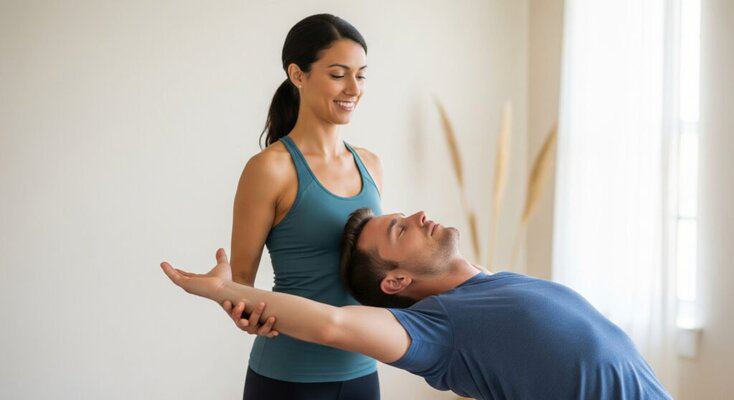
Final Tip:
This pose can be especially helpful for people who:
- Struggle to ask for support
- Feel uncomfortable being vulnerable
- Are working on rebuilding relationship trust
If tears come up — let them. That’s yoga doing its deeper work.
Guided yoga healing tracks, essential oils for relaxation, or trauma-informed yoga resources
Closing the Practice with Intention
After exploring these 7 fun yoga poses for 2 people, it’s essential to ground the energy and seal the experience.
Here’s a simple yet powerful closing ritual:
Seated Eye Gazing + Gratitude Sharing (2–3 minutes)
- Sit cross-legged, facing each other.
- Close your eyes. Take 3–5 deep breaths together.
- Open your eyes and gaze gently into each other’s (no need to force it).
- One by one, say one thing you appreciate about the other person in this session.
Examples:
- “I felt really supported when you held my hips during the plank pose.”
- “I love how safe I feel around you.”
This part turns your yoga into a soul-deep bonding practice — not just physical alignment.
Bonus Tips for Maximum Connection
- Set the mood: Use calming music, dim lighting, and even aromatherapy oils.
- Turn off phones: This is sacred time — be fully present.
- Breathe together intentionally: Sync your breath during each pose.
- Touch consciously: Every grip, press, or hold can be a form of silent care.
- Laugh freely: Acro yoga and partner poses can get silly — embrace the joy!
Call to Action (CTA)
Ready to build deeper bonds, more flexibility, and trust in your relationships — all while having fun? To deepen your journey, don’t miss our complete guide on the best yoga poses for every body type and goal — it’s packed with tips, visuals, and beginner-friendly routines to help you thrive.
Whether you’re in a romantic relationship, friendship, or parent-child duo, partner yoga brings play, presence, and healing into your connection.
FAQs
1. What are the best yoga poses for 2 people who are beginners?
Start with simple poses like Seated Spinal Twist, Partner Breathing, and Double Child’s Pose. These require minimal flexibility and focus on trust and balance.
Tip: Always communicate clearly and prioritize comfort.
2. Is couples yoga the same as acro yoga?
Not exactly. Couples yoga focuses more on emotional bonding and flexibility, while acro yoga involves acrobatics, strength, and balance with one partner often lifting the other.
Acro yoga is a sub-type of partner yoga but more physically demanding.
3. Can two people do yoga every day?
Absolutely! Daily partner yoga can:
Deepen your emotional connection
Build physical strength and flexibility
Help couples manage stress and arguments better
Start slow and adjust intensity based on energy levels.
4. What should I wear for partner yoga?
Wear breathable, stretchy yoga clothes. Avoid anything slippery or too loose. You’ll be in close contact — comfort and modesty both matter.
Fitted tank tops and yoga leggings work great for both partners.
5. Is partner yoga only for romantic couples?
Not at all! Partner yoga can be practiced between:
Friends
Siblings
Parents and kids
Therapy partners
Any relationship can benefit from trust-based, mindful movement.
Final Thoughts
Partner yoga isn’t just about the poses — it’s about the connection between the people in them. Whether you’re giggling through a balancing pose or releasing tears in a stretch, it’s all valid and valuable.
Disclaimer
This blog post is for informational purposes only and does not constitute medical advice. Always consult a qualified healthcare provider before starting any supplement or treatment. This article may contain affiliate links, which means we may earn a small commission (at no extra cost to you) if you make a purchase. We only recommend products we personally trust.

